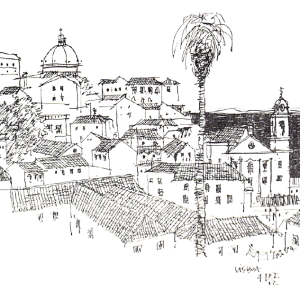About travel drawings
Keywords:
drawing, practice, travel, architectAbstract
“Drawing is a pleasure. The pleasure of drawing means to be in a certain place enjoying of magic moments…” This quote sums up the topic of the conversation with the prolific architect Alejandro Beltramone. Reflecting on his training at the Faculty of Architecture, Planning and Design, he highlights the teaching contribution of Professor Japo Schira who was always drawing together with his students. It is this contribution that has become the basis of a fundamental principle when dealing with registration drawing. Beltramone analyzes not only his subsequent personal experience on this type of practice but also the unique features and adjustments of graphic records carried out since 1987 in order to shape the records of a traveler by means of different types of media. He deals with the specificity of an in situ drawing as well as the reading and portraying of magic places tours (Florence, Cuzco, Lisbon, Valparaíso). Thus, he synthesizes the acquired and the transmitted along with the meaningful experiences sketched by Le Corbusier as a traveler. He concludes with findings concerning students’ acquisition and implementation of a practice in which “…motivation is more important than talent…”
Downloads

Downloads
Published
How to Cite
Issue
Section
License
Open access policy
A&P Continuidad is a non-profit and open access publication. According to Mexico Declaration on Cultural Policies, the journal distribution is submitted to Creative Commons Attribution-Noncommercial-ShareAlike 4.0 International Public License (CC BY-NC-SA). “Neither the commercial use of the original work nor that of the possible derivative works are allowed. The distribution of derivative works should be submitted to the license regulating the original work. This license is not free.”
A&P Continuidad authorizes the partial or full reproduction of texts and graphs provided that the source is cited. Authors are exclusively responsible for the criteria expressed in the articles which do not necessarily reflect the opinion of the Editorial Committee or that of the Direction Board. The copyright of the published articles pertains to their authors or publishers.
Transfer of rights
The acceptance of an article to be published implies the author’s transfer of rights to the journal. Authors continue to have the right to use the material in future books or publications, approve or veto the republication of their works as well as the rights related to patents or other rights. Transfer of rights form may be downloaded here.























 This OJS site and its metadata are under a
This OJS site and its metadata are under a 

